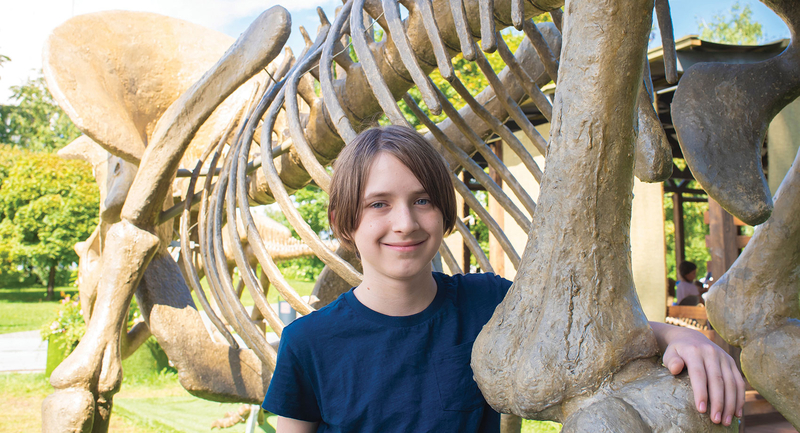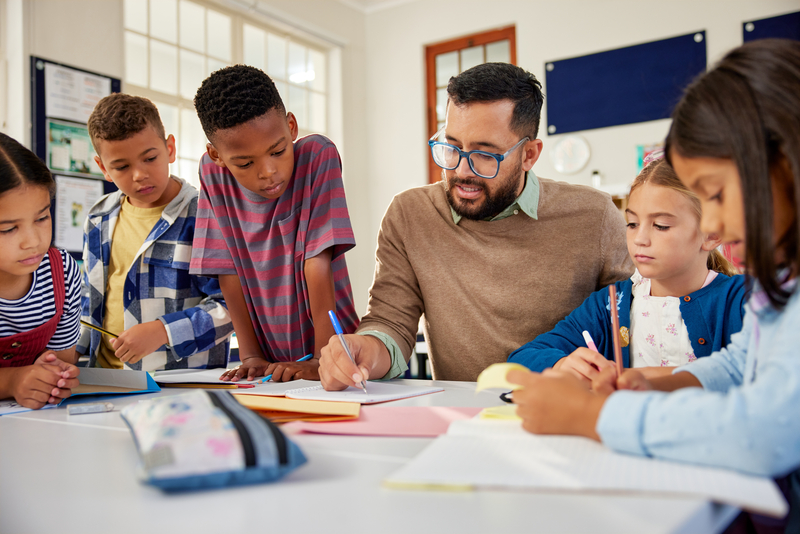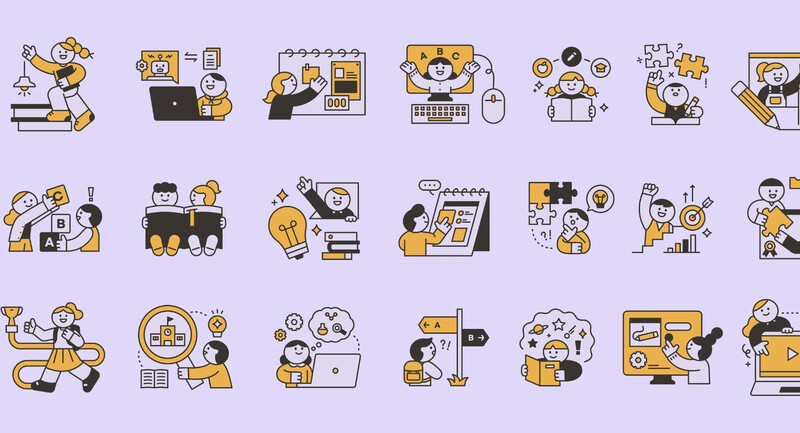On a recent visit to an elementary school in Worcester, Massachusetts, I watched a teacher pull out a cup of popsicle sticks bearing students’ names. She planned to use them as a tool to encourage all her 5th graders to participate in a discussion about the classic fantasy novel The Phantom Tollbooth by Norton Juster (Random House, 1961), the key text in a larger unit on word play and how we use words to define and organize our world. The unit included other texts as well, and the kids watched Abbott and Costello’s classic bit, “Who’s on First?” The teacher knew her students were engaged in the lesson, but planned to use the popsicle sticks to ensure the children participated in the class conversation and that a diverse mix of students’ voices were heard.
Minutes later, the teacher set the sticks aside as hands shot up and students joyfully jockeyed to share their ideas. The sticks weren’t actually needed, and the teacher ended up breaking the students into small groups so every student had a chance to share their ideas and predictions.
That’s what it can look like when students are reading the same high-level book, engaging in meaningful work, and participating in rich discussions. Unfortunately, that’s not the reality in enough classrooms.
Too often, instead of “teaching up,” as Carol Ann Tomlinson (2023) aptly refers to the practice of supporting all learners so they can access the same rigorous content, students are siloed in groups. They often get different books instead of reading a single grade-level text with the support they need. That means while one 5th grade student reads The Phantom Tollbooth, her tablemate might be reading Amelia Bedelia books. Both use word play, but the rigor of the first is captivating and, at times, puzzling. The other is a simple introduction to word play with obvious moves, removing the requirement to think deeply. In many classes, students are independently responding to comprehension questions about their assigned texts, rather than jointly building their comprehension and skills through the rereading and discussion of a shared text. Slowly but surely, this kind of ineffective yet widely practiced differentiation undermines the building of background knowledge and comprehension skills, drawing same-grade learners further and further apart.
As Tomlinson has noted in her work, this isn’t just a problem in literacy classrooms. Across subject areas, there is often an instinct to try to meet students where they are, instead of where they should be, especially amid post-COVID achievement declines (National Center for Education Statistics, 2022).
Dave Beedy, director of STEM education for public schools in Elmhurst, Illinois, recently explained that teachers in his district were concerned about interrupted learning during the pandemic and wanted to reteach prior years’ content to fill in holes when in-person learning resumed. But he said district leaders held the line at prioritizing grade-level standards during core instruction.
“We’ve been very focused on strongly adhering to grade-level standards in our classrooms,” Beedy said. “We didn’t want to look backward—we wanted to look ahead and set high expectations for our students.”
In Beedy’s district, teachers lead a grade-level lesson, and then use the end of a 50–75-minute math class to address learning gaps. With this approach, the district has surpassed pre-pandemic achievement levels.
How can schools nationwide similarly raise achievement while meeting the needs of individual students? That requires using evidence-based strategies and systematically building students’ background and content knowledge.
Students need to develop deep knowledge about a subject to understand what they’re reading and be able to discuss or write about it.
Reading Strategies That Work
Reflecting back on that lively discussion about the Phantom Tollbooth and word play I observed in the Massachusetts school, students learned that artists and authors intentionally use words and images to cause confusion and humor. As students read and discussed The Phantom Tollbooth, the teacher guided them through the text in different ways. In the first few chapters, students focused on using their knowledge of story elements to identify the main characters and events. Once students had a basic understanding of the structure of the story, they began to read more closely, examining the puns and figurative language that provided humor and deeper meaning to the characters’ journeys. Discussion, rereading, partner reading, and graphic organizers are ways of teaching up and supporting all students to enjoy and learn from a complex text.
Similarly, in a 3rd grade classroom at San Tan Heights near Phoenix, I saw wide-eyed students listening attentively as their teacher read the book Giant Squid: Searching for a Sea Monster by Mary Cerullo and Clyde Roper (Capstone, 2012) as part of a series of lessons on the sea. This is a challenging informational text, but students previously spent weeks building background knowledge about the ocean habitat and ocean explorers through other informational texts, picture books, poems, and the Japanese woodblock print The Great Wave off Kanagawa. These were introduced and organized in such a way to spark curiosity and build foundational knowledge and vocabulary of the sea before moving into harder books. Research shows that systematically developing background and content knowledge on a topic boosts language comprehension. In other words, the more you know about a topic, the easier it will be to read and discuss a complex book on it—and, hence, acquire even more knowledge (Wexler, 2020). That’s much better than assigning books in a scattershot way, with a focus exclusively on building skills such as finding the main idea or making inferences. Students need to develop deep knowledge about a subject to understand what they’re reading and be able to discuss or write about it.
There are specific strategies that can help struggling readers or those with limited English proficiency keep up with reading assignments. One is to preview vocabulary words and concepts in a book, so children aren’t coming upon those cold. For example, previewing the terms tentacle, kraken, and colossal with images will help students begin to build an idea of what Giant Squid by Candace Fleming (Roaring Brook Press, 2016) will be about and prepare them for better comprehension when those words appear in the text. The teacher might also show a video of a marine biologist at work to help students understand the context of the book. Teachers can also read aloud to students or ask students to read to one another. Reading aloud can deepen engagement, build vocabulary, improve comprehension, and increase phonological awareness (Lennox, 2013).
Posing questions to students about the text, whether it’s a book, article, or painting, can also spark a child’s curiosity and boost engagement. When my colleague Lorraine Griffith, now a curriculum writer, taught elementary students in Buncombe, North Carolina, she loved to read aloud Jan Greenberg and Sandra Jordan’s book Action Jackson (Square Fish, 2007), about the artist Jackson Pollock. First, she’d ask the kids what they notice and wonder about the book. Then, she’d ask about word choices like “swoop” and “leap” and how they connected to Pollock and his artistic style. She would invite students to act out these words, building vocabulary while evaluating an author’s word choices. Part of teaching up in ELA is helping students really understand the richest part of the text, passages that are often glossed over when students are left to do most of the reading independently. Finally, the class compared Pollock’s style to other artists they studied. Lorraine says the level of discussion and engagement was remarkable, because every student had something to contribute.
Visualizing Math in New Ways
All students should have equal access to grade-level instruction in math with natural scaffolds and differentiated techniques built into core instruction. These strategies are often helpful to all students, but they are absolutely essential for some of them.
To build students’ knowledge and understanding of math concepts, it’s helpful to use concrete and visual representations before moving to abstract ideas and problems. For example, you can bundle “concrete” items like sticks or crayons to help early elementary students understand place value, or that 10 ones make one ten. Then, students can use mathematically “representational” models and drawings (such as a number line) to learn concepts and solve problems before trying to use “abstract skills” such as a standard algorithm or solving problems in their head.
Teaching students different models and varied ways of using them encourages flexible thinking and helps some kids avoid getting stuck on a math problem. For instance, a teacher might introduce a visual model like a tape diagram, a rectangular model used to illustrate number relationships, to help 1st grade students solve simple addition. Then, in 5th grade, some students might use that tape diagram to explain and solve a complex word problem.
Here’s what that might look like in practice:
Briefly activating students’ prior knowledge before introducing new math material supports learners by preparing them to add to their mathematical knowledge, helping them organize their thinking and building their confidence. It’s also critical to provide students with time to practice and absorb what they learned. So, if a teacher leads a lesson on a core concept in math, students need time to engage in tasks related to that concept after the lesson is delivered. Many of my colleagues adhere to the 10:2 principle—for every 10 minutes a math teacher talks, students need 2 minutes of interactive time to apply and practice what they’ve learned.
Showing kids how to apply math in the world beyond the classroom also supports engagement and deepens understanding for all students. For example, teachers might ask students to determine the area of a room in a given floor plan, or they might ask them to calculate a restaurant tip in a lesson on percentages.
It’s also important to avoid a focus on rote memorization and the use of easily forgettable math tricks. Remember that old butterfly method for adding fractions? It was a commonly taught gimmick involving drawing wings around numbers. But tricks like that fail to build math knowledge and make kids more prone to mistakes when problems get harder. It’s also important to avoid overly complex language in math instruction, most notably with word problems, to avoid creating obstacles for students with reading-related learning disabilities. This was a problem for my 17-year-old who has dyslexia. They excel at math but sometimes struggle with language on math assignments. Putting readability at the center of math resources is vital to ensuring all kids have access to high-quality instruction.
Across subject areas, there is often an instinct to try to meet students where they are, instead of where they should be.
Science Instruction That Soars
It would be a mistake to overlook science instruction when talking about core content and the need to ensure all kids experience opportunities to learn at grade-level and above. Students need high-quality science instruction to be knowledgeable citizens of the world and prepared for future-ready careers, but it’s been deprioritized in schools. In a national survey, elementary teachers reported spending just 18 minutes a day on science, and that figure has likely declined given the current, post-pandemic focus on math and reading achievement (Horizon Research Inc., 2020).
And too often science instruction has, like math, focused on memorizing facts or learning the scientific method, a model aimed at teaching kids to “think like scientists,” but without learning strong science content. Students should be doing science, not just learning the steps of a method.
There are specific elements of high-quality science instruction that benefit all students and support learners who may struggle in other subjects. For starters, science instruction should be anchored by authentic, real-world scientific phenomena. And just like in math and reading, building student knowledge of that phenomena should involve learning about it in a layered way—through books, visual models, hands-on investigations, and art.
At San Tan Heights, for example, 4th graders study how the features of the Grand Canyon were formed. They read about the expeditions of John Wesley Powell, study photos of the natural wonder, and examine a Thomas Moran painting of the Grand Canyon. In addition, students conduct hands-on investigations to understand weathering by observing how one material can break down another material, and they use a stream table to see how weathered rock or sediment moves from one place to another to understand erosion.
Students benefit from drawing and referencing visual models of the phenomena they’re studying to help organize their thinking as they build new knowledge. They can use felt cut-outs, paper and pencil, whiteboards, or digital tools. And they also can work together to create and use a chart that summarizes the foundational concepts they’re learning about.
Teachers should provide the same core instruction and opportunities to learn to all students, but by building knowledge in this rich, varied way, they can ensure all students have access points to the lessons. For high-achieving students, teachers can layer in extension work, such as assigning independent research projects or supplementary reading material.
Finally, the hands-on nature of science and engineering challenges, which are embedded in high-quality science curricula today, have the potential to disrupt the traditional hierarchy of classrooms, allowing kids to lead who might otherwise be reserved. I’ve seen the quietest kids take charge in small-group settings where they were asked to design and build a model windmill that generates electricity, or to design and test a sustainable irrigation system. Research shows this kind of hands-on science and engineering learning can even lead to more rigorous course placement recommendations for low-income and culturally diverse students (Robinson et al., 2018).
Knowledge Matters
Across subject areas, schools must help all students build enduring knowledge of rigorous core content. That means supporting children in accessing complex books, providing them with multiple methods for solving problems and understanding concepts in math, and supporting critical thinking and real-world problem solving in science.
It’s not enough to find the main idea in an English class, learn math through rote memorization, or study the scientific method without applying and learning about scientific phenomena around us. If we leave knowledge behind, we’ll leave students behind.
Tomlinson has been using the term “teaching up” for well over a decade, but perhaps it has never felt more relevant and more urgent than it does today, given the diverse learning needs of students and achievement patterns we’re seeing since the pandemic upended education. It’s essential that more schools look for ways to teach up and give every child the education they need to live out their dreams and succeed in their future endeavors.









